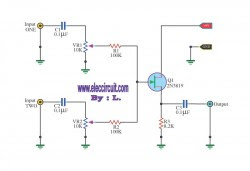
This circuit is designed to check the condition of lead-acid and gel cell batteries with capacities greater than 20Ah. It switches a load of about 18A at a rate close to 50Hz so that the internal resistance of the battery can be measured using a digital multimeter across the battery terminals. The measured AC voltage in millivolts divided by 10 (ie, a shift of the decimal point) is approximately equal to the battery’s internal resistance in milliohms. As shown, the circuit is quite straightforward and is based on two 555 timer ICs (IC1 & IC2) and power Mosfet Q1. IC1 operates as a monostable timer with a period of 10s.
When switch S1 (Test) is pressed, IC1′s pin 3 output goes high for 10s and this enables IC2 which operates as a 50Hz astable oscillator. IC2 in turn drives power Mosfet Q1 which is connected across the load in series with three 0.22W 50W resistors. IC2 then turns off again after 10s – ie, at the end of the monostable timing period. LED1 provides power indication when the circuit is connected to a battery, while LED2 (green) comes on during the test period. The thermostat is not necessary unless the unit is to be used repeatedly (the Jaycar ST-3823 70°C unit is suitable) and you want to protect the output circuit against overheating.
The power Mosfet does not need cooling but the thermostat and the 0.22W 50W resistors should all be mounted on an aluminium heatsink at least 2mm thick. In practice, the internal resistance of car batteries can vary from about 15mW down to about 3mW. Before testing the battery, check that the electrolyte level is correct and that the voltage across its posts exceeds 12.5V for a nominal 12V battery; ie, close to full charge. That done, switch on the car’s headlights and measure the DC voltage between each battery post and its connecting terminal. It should be less than 10mV in both cases; if not, the terminals need cleaning. Once you’ve done that, you can turn off the headlights, connect the tester and proceed with the internal resistance test. Be sure to connect the multimeter’s test probes directly to the battery posts, to read the internal resistance (not the battery terminals).
S:www.extremecircuits.net
















